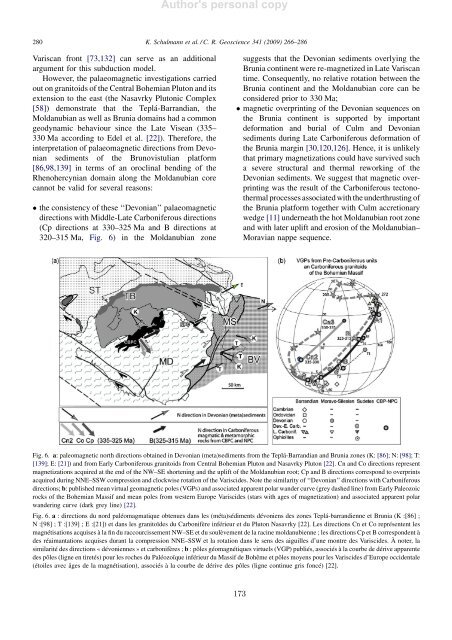Quantitative structural analyses and numerical modelling of ...
Quantitative structural analyses and numerical modelling of ...
Quantitative structural analyses and numerical modelling of ...
Create successful ePaper yourself
Turn your PDF publications into a flip-book with our unique Google optimized e-Paper software.
Author's personal copy280K. Schulmann et al. / C. R. Geoscience 341 (2009) 266–286Variscan front [73,132] can serve as an additionalargument for this subduction model.However, the palaeomagnetic investigations carriedout on granitoids <strong>of</strong> the Central Bohemian Pluton <strong>and</strong> itsextension to the east (the Nasavrky Plutonic Complex[58]) demonstrate that the Teplá-Barr<strong>and</strong>ian, theMoldanubian as well as Brunia domains had a commongeodynamic behaviour since the Late Visean (335–330 Ma according to Edel et al. [22]). Therefore, theinterpretation <strong>of</strong> palaeomagnetic directions from Devoniansediments <strong>of</strong> the Brunovistulian platform[86,98,139] in terms <strong>of</strong> an oroclinal bending <strong>of</strong> theRhenohercynian domain along the Moldanubian corecannot be valid for several reasons: the consistency <strong>of</strong> these ‘‘Devonian’’ palaeomagneticdirections with Middle-Late Carboniferous directions(Cp directions at 330–325 Ma <strong>and</strong> B directions at320–315 Ma, Fig. 6) in the Moldanubian zonesuggests that the Devonian sediments overlying theBrunia continent were re-magnetized in Late Variscantime. Consequently, no relative rotation between theBrunia continent <strong>and</strong> the Moldanubian core can beconsidered prior to 330 Ma; magnetic overprinting <strong>of</strong> the Devonian sequences onthe Brunia continent is supported by importantdeformation <strong>and</strong> burial <strong>of</strong> Culm <strong>and</strong> Devoniansediments during Late Carboniferous deformation <strong>of</strong>the Brunia margin [30,120,126]. Hence, it is unlikelythat primary magnetizations could have survived sucha severe <strong>structural</strong> <strong>and</strong> thermal reworking <strong>of</strong> theDevonian sediments. We suggest that magnetic overprintingwas the result <strong>of</strong> the Carboniferous tectonothermalprocesses associated with the underthrusting <strong>of</strong>the Brunia platform together with Culm accretionarywedge [11] underneath the hot Moldanubian root zone<strong>and</strong> with later uplift <strong>and</strong> erosion <strong>of</strong> the Moldanubian–Moravian nappe sequence.Fig. 6. a: paleomagnetic north directions obtained in Devonian (meta)sediments from the Teplá-Barr<strong>and</strong>ian <strong>and</strong> Brunia zones (K: [86];N:[98];T:[139]; E:[21]) <strong>and</strong> from Early Carboniferous granitoids from Central Bohemian Pluton <strong>and</strong> Nasavrky Pluton [22]. Cn <strong>and</strong> Co directions representmagnetizations acquired at the end <strong>of</strong> the NW–SE shortening <strong>and</strong> the uplift <strong>of</strong> the Moldanubian root; Cp <strong>and</strong> B directions correspond to overprintsacquired during NNE–SSW compression <strong>and</strong> clockwise rotation <strong>of</strong> the Variscides. Note the similarity <strong>of</strong> ‘‘Devonian’’ directions with Carboniferousdirections; b: published mean virtual geomagnetic poles (VGPs) <strong>and</strong> associated apparent polar w<strong>and</strong>er curve (grey dashed line) from Early Paleozoicrocks <strong>of</strong> the Bohemian Massif <strong>and</strong> mean poles from western Europe Variscides (stars with ages <strong>of</strong> magnetization) <strong>and</strong> associated apparent polarw<strong>and</strong>ering curve (dark grey line) [22].Fig. 6. a : directions du nord paléomagmatique obtenues dans les (méta)sédiments dévoniens des zones Teplá-barr<strong>and</strong>ienne et Brunia (K :[86] ;N :[98] ; T :[139] ; E :[21]) et dans les granitoïdes du Carbonifère inférieur et du Pluton Nasavrky [22]. Les directions Cn et Co représentent lesmagnétisations acquises à la fin du raccourcissement NW–SE et du soulèvement de la racine moldanubienne ; les directions Cp et B correspondent àdes réaimantations acquises durant la compression NNE–SSW et la rotation dans le sens des aiguilles d’une montre des Variscides. À noter, lasimilarité des directions « dévoniennes » et carbonifères ; b : pôles géomagnétiques virtuels (VGP) publiés, associés à la courbe de dérive apparentedes pôles (ligne en tiretés) pour les roches du Paléozoïque inférieur du Massif de Bohême et pôles moyens pour les Variscides d’Europe occidentale(étoiles avec âges de la magnétisation), associés à la courbe de dérive des pôles (ligne continue gris foncé) [22].173







